Chris and Larry:: When did you begin
assembling your images from multiple negatives?
Jerry: It was the late 1950s. I did a little bit then and then
it really took hold once I went to Florida in 1960.
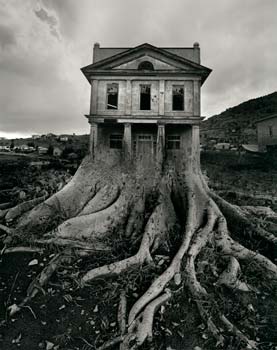
I had the benefits of studying with Henry Holmes Smith at Indiana
University. He had worked with Laszlo Moholy-Nagy in Chicago and was open
to all kinds of experimentation. He actually made photographs by
refracting light through syrup poured on glass.
Chris and Larry:: What led you to see the power in collage? At that
time, straight photography as done by Edward Weston or Ansel Adams was
considered the correct way to do photography.
Jerry: I had become restless with trying to find an image that
satisfied me in camera. The idea that the creative gesture in photography
was when you clicked the shutter was popular when I was a graduate
student. A lot of times I found that if I thought too much about the
image, Iíd talk myself out of shooting, or I ended up with a lot of images
that I thought were okay, but not quite good enough.
When I studied photography at RIT each darkroom had one enlarger. Then
when I started teaching we had a group darkroom. I was still using one
enlarger, which was labor intensive for multiple printing. One day while I
was waiting for some prints to wash, I looked across at the enlargers and
thought to myself that if I had the negatives in different enlargers and
simply moved the paper, the speed with which I could explore things or
line them up would increase a hundred times. That was the moment that
changed the way I worked with multiple images.
The other element, which was really a key factor, was that once I began
teaching, I ended up being the only photographer in an art department. I
was around creative people who were not photographers and who didnít have
their images occur in a fraction of a second.
Once I began exploring some of the options in the darkroom, I had
tremendous support from my friends on the arts faculty. But when I went to
New York to show people what I was doing they would be excited and say,
ďitís very, very interesting, but itís not photography.Ē
At the time photographyís highest form was seen in the work of
photographers like Paul Strand, Ansel Adams, and Edward Weston. If you
study art history, youíll see that there was a conscious effort to define
the separate mediums. Painting was oil on canvas, and sculpture involved
traditional materials like stone, wood or metal. And the photograph was
defined as a camera conceived silver gelatin print.
Chris and Larry:: Well, you certainly had the support of the art world.
You had a solo exhibition at the Museum of Modern Art in 1967.
Jerry: Yes, and that opened all kinds of doors; it was like being
blessed by the Pope. The irony is that John Szarkowski, who gave me that
show, later became a champion of photographers like Diane Arbus, Gary
Winograd, and Lee Friedlander and became less supportive of the
experimental tradition in photography.

Chris and Larry:: How did you start out learning photography?
Jerry: I went to Cooley High School in inner city Detroit. I had
terrible grades, but photography was a hobby. I worked part-time helping a
photographer at a studio where Iíd load film holders and carry a second
strobe unit when they shot weddings. Eventually, during high school, I was
shooting weddings.
Then I went to a two-year program RIT (Rochester Institute of
Technology) to be a portrait photographer. While I was there RIT expanded
into a four-year institution with both a photographic science and
illustration programs. Beaumont Newhall, who wrote the first popular
history of photography book and was director of George Eastman House,
began teaching. Then Minor White was hired. Minor would talk about images
that happened when the spirit came down and things like that. Until then
Ralph Hattersley had been the only RIT professor with a creative attitude
towards photography. Hattersley planted a lot of seeds, introducing me to
the concept that photography could be used for self-expression. Until then
I had thought of photography as doing assignments for others.
At the same time I was at RIT, Bruce Davidson was there. Pete Turner
was there. Carl Chiarenza, who went on to get a Ph.D. from Harvard in
photo history and Peter Bunnell were there. We had a critical mass for
open-ended thinking and discussion about what photography could be. These
individuals expanded my ideas about what photography could be. I really
feel blessed by that because had things gone differently, I could have
been a portrait photographer in Detroit.
After Rochester, I went on to Indiana University. I found myself very
disillusioned with the audiovisual program I was in. Then Minor told me I
should look up Henry Holmes Smith in the art department, and I started
taking some courses with him. I asked if I could change programs and work
on my Master of Fine Arts degree in the art department. Henryís first
response was ďIf you want to go on in art you have to be independently
wealthy.Ē I also had to take and pass an art history class to be admitted
to the program, which I did.
At the time you could have gathered everybody working with photography
as a fine art around a dining room table. Even Ansel Adams was still doing
a lot of commercial work. Photography as art had just not received a lot
of acceptance.
Chris and Larry:: It seems you were assembling your education like you
assemble your images. You were synthesizing elements of understanding from
the art world and the photography world. And at that time many people
still saw photography as a craft, not an experimental art form.
Jerry: Well your comment is right on. Thatís exactly it. Thereís
actually quote in Westonís Daybooks, where he goes to a museum and he sees
something that he really likes and thinks, ďGod, thatís something I could
useĒ. He thought that you use those things that are by rights of
understanding yours. So as various concepts were introduced to me, I would
think, ďThis is incredible.Ē Minor was the first role model I had who
truly did no commercial photography. He did creative photography and
taught and then he hung exhibits. I didnít know people like that existed
before. But I did, as you mentioned, bring together various aspects of my
educational encounters to create whoever I am, my identity as an
image-maker.

Chris and Larry:: Letís talk more about your creative process. When
youíre seeking what you have called a Ďreality that transcends surface
realityí, where do you begin? Where do you find the inspiration to choose
the elements and to assemble the picture as versed to taking a photograph?
Jerry: My creative process begins when I get out with the camera and
interact with the world. A camera is truly a license to explore. There are
no uninteresting things. There are just uninterested people. For me to
walk around the block where I live could take five minutes. But when I
have a camera, it could take five hours. You just engage in the world
differently. If you can get to a point where you respond emotionally, not
intellectually, with your camera thereís a whole world to encounter.
Thereís a lot of source material once you have the freedom of not having
to complete an image at the camera.
Of course as I developed a way of building images in the darkroom, this
also fed back into the way in which I saw the world. So if I find an
interesting tree or rock I think, ďGee, that could be a wonderful
background for something.Ē I begin to build a vocabulary based on things
that I encounter and then I start photographing things specifically for
use in my darkroom. I may photograph objects on a light box so they have a
white background or shoot things on black velvet so I can sandwich those
negatives later in the darkroom
But my initial approach is very non-intellectual. I just canít
emphasize that enough. Today there is a lot of conceptually based art that
begins with a particular theory and then the individual makes the images
to fit. Itís like an assignment, all planned and then they just follow
through and do the work. My approach is a lot less premeditated
Chris and Larry:: More of a spontaneous response to the world?
Jerry: Yes, and as a result I think my work has been very challenging
for some people to deal with. A lot of it is psychologically and
emotionally based. Thatís harder to write about than art that is
theory-based, as much contemporary art and post-modernism is. Plus, over
the course of the year I make some images that are very playful, others
that are very dark. Some of them no one would want to have on their wall.
But Iím the first audience, so Iím making them for my own satisfaction.
Chris and Larry:: Your work has been analyzed in terms of Carl Jungís
theory of the Collective Unconsciousness and its concept of Archetype. Do
you see your work that way?
Jerry: Well, yes. And, in todayís art world French philosopher Jacques
Derridaís theory of multiple meanings is also having an influence. Thereís
not a common syntax in a lot of visual material so people respond to it
differently. When you have subjects that are really open-ended, like a
floating rock or a tree or whatever, that causes the consciousness of the
viewer to come up with their own way of connecting with that image. Itís
the audience that completes the cycle.
This, to me, is the wonderful part of photography and all the arts.
There is a kind of an emotional impact that can be felt when you see
certain images. It goes beyond communication, as we know it. Once you have
seen Edward Westonís photograph of the pepper, you canít pass them in the
grocery store without thinking about these things as aesthetic objects.
Westonís vision took a common vegetable to a new level. Thatís the aspect
of art that I like.
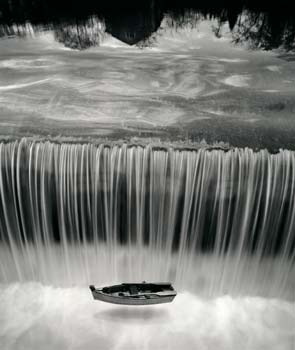
Chris and Larry:: Your work can be seen as very complex, or quite
simple.
Jerry: The joke that I tell when I lecture to art students is Ďwhat
happens when you cross a post-modernist with a used car salesman?í The
answer is you get an offer you canít understand. That always draws a big
laugh from the college students because theyíre required to read stuff
that is so complex that much of it doesnít make any sense, at least not to
me.
Chris and Larry:: Youíve spoken about risk taking and even how
self-doubt can be part of the creative process. Can you tell us more about
that?
Jerry: Well, I do think, particularly the way I work, the better images
occur when youíre moving to the fringes of your own understanding. Thatís
where self-doubt and risk taking are likely to occur. Itís when you trust
whatís happening at a non-intellectual non-conscious level that you can
produce work that later resonates, often in a way that you canít
articulate a response to. So much of what we consider knowledge involves
being able to state something in words. But there is another level at
which things impact us in a visual way that we really canít articulate a
response to.
Chris and Larry:: But nonetheless, we have a visceral or an internal
connection to some of the elements.
Jerry: Right. Thatís important. Iíve enjoyed teaching photography to
all kind of students from beginning to graduate level, and Iíve always
felt that walking around with their cameras gave them all kinds of
insights that were as important as spending hours in the library.
Chris and Larry:: You have for many years been the acknowledged master
of multiple printing and the art of physically collaged images in the
darkroom. Iíd like to pull a quote out of your new book, Other Realities,
which I think itís truly eloquent. ďI am sympathetic to the current
digital revolution and excited by the visual options created by the
computer. However, I feel my creative process remains intrinsically linked
to the alchemy of the darkroomĒ Weíve talked mostly about the aesthetic of
your work. Perhaps we can talk a bit about your technique and the digital
revolution that is going on in photography.
Jerry: Itís interesting how many people assume itís a competition.
Actually, Photoshop has generated a much broader audience for my work.
When I started people questioned if my work was really even photography,
it was so different than the Group f64 approach. Now there are new
audiences for my work. And young people who are learning digital skills
discover that the real challenge is coming up with an image that
resonates, first of all, with your self and hopefully, with an audience.
They can learn all these new techniques and think that theyíre easier to
use, but creating great images isnít about the tools.

Chris and Larry:: Your wife, Maggie Taylor, is a major digital artist.
Jerry: Yes, and sheís having huge success. Sheís a wonderful
image-maker. We both actively engage in the image making process, and work
a seven-day week. Itís not uncommon for her to be at the computer and me
to be in the darkroom many evenings.
I see the incredible options that Photoshop provides. But the bottom
line is the technique has to fit with ideas and images. I fell in love
with the alchemy of the photographic process and to this day, watching
that print come up in the developer is magic for me. I still find it a
wonderful, challenging experience. Itís also a kind of personal therapy
for me just to engage in that process. If travel and other work keeps me
out of the darkroom a couple of weeks, Iím not a nice person to be with.
Of course, in order to make art, the frustration of not working has to
be greater than the frustration of working. I try to push images as far as
I can. Sometimes I go too far, then as time passes, I think, ďThat was
stupid or overkillĒ or whatever. But you have to go to those places. You
canít just say, ďWe have an hour to talk on the phone, letís only be
profound.Ē You start wherever you can and then you work at it.
For me, every year I produce at least 100 different images and at the
end of the year, I try to sit back and look at them and find ten that I
like. Many years, itís hard to find those ten.
Chris and Larry:: Youíre making judgments when youíre looking at those
100 images that youíve created, do you solicit feedback from others as
well? Or is it mostly an internal dialog with your self?
Jerry: Actually, thatís a good question. I have some very wonderful
friends in academia and the arts. For years Iíd have these close friends
over to look at the prints and Iíd ask, ďIf you could have ten of these
prints, which ones would you want?Ē I didnít want a heavy intellectual
analysis, just personal responses to the images. The crazy thing was that
in most cases, there was not a lot of agreement. Obviously, there would be
some overlap, but itís a big world out there and people do bring their own
sort of aesthetic to bear. But Iím the one that ultimately has to decide
when I send things off to finally be in an exhibit or be published.
Itís not easy. Sometimes I have a kind of cognitive dissonance. There
are images that Iíve worked on for so long and have fussed over so much
that I think they just have to be good. The amount of energy I put into
creating them becomes a factor for me. Those are ones that, as time
passes, I might later reject. At other times, an image may just involve
two negatives and a simple blend, but people say, ďHey, this is a great
one.Ē Iím thinking, ďWell, that was a little too easy.Ē But thatís really
not the case.
Chris and Larry:: So when you build an image from multiple negatives or
from multiple images that youíve assembled, is that process additive or
subtractive? Do you start off with one and then add another, or do you
start off with a bunch of images and then say, ďLetís put these four
together and see what they doĒ?
Jerry: Itís always additive process. Itís hard to think beyond two or
three to begin with.
Iíll give an example. We were just invited to Seoul, Korea, for an
opening at a beautiful photography museum over there. We had one day out
into the countryside in one of their traditional towns and I had a chance
to photograph. I shot about ten rolls of film while I was over there. When
I came back, I processed those and the contact sheets then became the
foreground for me as I had just been there and made those photographs.
Then I started looking at different backgrounds, at combining things with
them. Itís interesting because once I start doing it, I remember other
negatives and things that might work with some of these things.
Now in the course of the last month, Iíve worked through most of those
negatives. I donít really sense anything else that I can do with them at
this point. But I can guarantee that five years from now, some of those
things that Iíve rejected will find there way into other images.
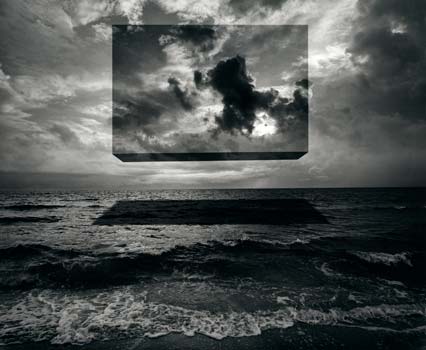
Chris and Larry: How much time and experimentation takes place
in the darkroom?
Jerry: Once Iím set up I need at least a six-hour block and preferably
an eight to ten hour block to do what I do. Computer people have this
advantage over the darkroom people by far.
Two weeks ago in Yosemite I shot this rushing water hitting a rock in a
stream; it was like this wave in the middle of this river. Then I added a
water background with strange clouds. So at the end of the day, I have
this all set up. I have my chemistry. Iíve been testing with the different
enlargers. Thatís when I want the Holy Ghost to tell me with a whisper in
my ear, ďJust do three of thoseĒ. But as I age now, Iím 72, I think, ďIíll
never print this again.Ē I have too much going on. I want to keep making
new images.
I made ten prints and then in the middle of the night, Iím thinking,
ďThat shape that this water bows up in is like the shape of an eye.Ē I
hadnít taken the negatives out of the enlarger yet so the next day, I made
12 prints of the image with the rising water lighter and added an eye. I
liked it better. From my point of view, if I can improve an image 2%, Iíll
be back in the darkroom the next day.
Chris and Larry:: You mentioned the process of producing the work in the
darkroom naturally creates an edition. In fact, even if you just pulled a
negative out and put it back in, perhaps somebody with really sharp eyes
would notice that there was a slightly different orientation to some of
it. Do you then limit, or number editions created like that?
Jerry: This is a constant discussion in my life. All these gallery
people now want me to limit editions. But you see, I like the idea that
photographs exist as multiple originals.
Ansel Adams was a friend and I asked him back in the early Ď70ís about
this issue. Now this is a guy that made 50,000 negatives and he told me
back then that he had about 15 images that sold regularly Ė out of 50,000!
And his most popular image, Moonrise, he admitted to making over 1,000
prints. Iíll bet he made at least 2,000 prints of it in all sizes.
Editions made sense when people worked with engravings where the plate
wore down as prints were made. An early number of the edition had slightly
better quality. But thatís not the case with photography.
To me, itís a false way of creating value. But there are people out
there whose prices are going up and theyíre selling out editions and that
sort of thing. Iím not in that school. I figure Iím the only guy thatís
doing my prints. Once I go to the great darkroom in the sky, whatever
prints exist, thatís it.
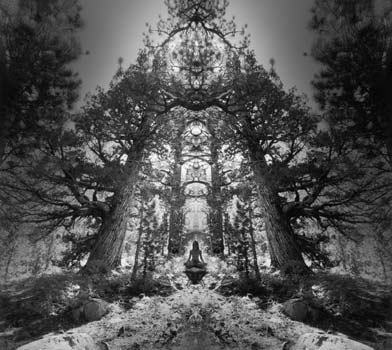
Chris and Larry:: Still, your initial print runs are small.
Jerry: Iíll just make six prints of something usually. Why make more?
People say, ďIsnít it a problem to go back and reprint it?Ē Itís not a
problem - in fact the second time Iím creating these images I can focus on
the craft. The first time, youíre doing all the mental gymnastics about
what does it mean. When I reprint something I feel that I end up with
better prints than I did the first time.
Chris and Larry:: Do you ever scan your finished prints?
Jerry: I actually have people now that are scanning my work so there
will be a record of almost everything, certainly my most popular images.
In the old days if someone wanted to use an image I had to make copy
prints, 8x10 glossies on resin coated paper. But Iím amazed how itís all
done electronically now. Iím really blessed by having a wife with all of
these skills.
Chris and Larry:: Do you think it is easier to create images using a
computer?
Jerry: Itís equally hard and labor intensive to create an image on the
computer as it is in a darkroom. Believe me.
Chris and Larry:: The elegance way you bring images together is
impressive. A floating rock will have the right light and shadowing to
match the background and other elements appear give it context. That makes
even an implausible combination appear possible. Is your understanding of
light and perspective intuitive, or is that part of the intellectual
process?
Jerry: Its luck and intuition. Photographs in general have an inherent
believability, and the overall impact of an image can keep people from
noticing some of the slight discrepancies. Also, I prefer negatives shot
on overcast days as they give you greater flexibility.
Chris and Larry:: Do you still go out and shoot a lot?
Jerry: I tend to shoot more when we travel. I taught workshops with
Ansel in Yosemite for years, but really didnít get much time to explore
the park. Later, when my wife and I visited we explored more, going on
pack trips with other artists. I try to go every year. In September we go
to the high country, renting tent cabins the last week before snow closes
that part of the park. This year after Yosemite we went to San Francisco
for a few days, and then to Korea. I shot 23 rolls on that trip.
Chris and Larry:: What kind of equipment are you using now?
Jerry: Iím currently using a Mamiya 7 and a Bronica GS1. I also have an
old Bronica that Iíll use for the studio stuff but I want to carry the
lightest equipment that will give me the biggest negative I can get and
still use roll film.

Chris and Larry:: Have you shot large format or 35mm recently?
Jerry: No. The last time I shot 35mm, other than to make slides, would
have been in the early Ď60ís. And when I first went out and taught
workshops with Ansel, I found that I could shoot two rolls of film by the
time those people had set up their view cameras. They were trying to do
the zone system, which I think is overrated. Iíd much rather be
emotionally involved.
Chris and Larry:: Would you have any advice for those who would like to
pursue the fine art market and to use their photographic vision as a
creative approach?
Jerry: I know a lot of really wonderful commercial photographers, and
every one of them has their personal work in their desk drawer. Ryszard
Horowitz is a friend who does major high-end commercial stuff. And believe
me; heís certainly as creative as I am.
There are people like Duane Michaels and who can do both commercial and
fine art work. I have a lot of respect for that. People that are only
doing very personal fine art photography have to have some support system.
If theyíre well connected with a gallery in New York, that might do it.
But the art world is constantly changing. There are all kinds of art
movements that constantly come into vogue and then fade away. In
photography we have the phenomena of the huge color prints done by people
like Andreas Gursky and Thomas Struth. Theyíre amazing to see, but again,
thereís a point at which once every museum has one where does that trend
go?
I just read an article in last Sundayís Times where these curators are
talking. The one said itís sad how the emphasis is so much on new that
many artists who are doing some of their better work at their mid careers
or later careers are being neglected for the sake of constantly showing
the new, young kid on the block.
In my own case, if you went to the Museum of Modern Art and said weíd
like to see what you have by Uelsmann in the collection, theyíll have some
work, but itíll all be from the Ď60ís. Thatís when I was new on the scene.
Chris and Larry:: But you are still working, producing new images all
the time.
Jerry: To me, itís such a rewarding experience to be able to produce
personal imagery and have this kind of visual myth emerge over a period of
time, making images that can evoke a different perception of our world. We
are unique in that we can invent these realities.
Chris and Larry:: And perhaps on some deeper level, even understand
them.
Jerry: You bring up a very good point. The understanding can happen at
a non-verbal, intuitive level. There are images I have seen done by
students of mine whose names I do not remember, but I sure do remember
those images, so theyíve made an impact on me.
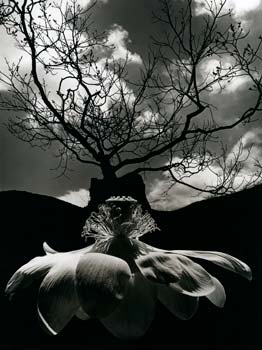
Chris and Larry:: You taught for 38 years, how did you challenge
students to be the most creative and effective photographers they could
be?
Jerry: The best teachers answer questions with more interesting
questions. That really sums it up. This is what Iíve learned after years
of teaching that education is essentially a question raising business.
I expected students to be showing work on a regular basis, because
thatís where a lot of the growth occurs, and to show work in process,
because people are a lot less defensive. Many places emphasize theory, but
I felt strongly that producing images was most important.
I tried to challenge people to define what they were doing, to try to
articulate what they thought they were doing. I realize I canít create a
verbal equivalent for my photographs, but weíve talked for over an hour
about what I think Iím doing and they should be able to do that.
I taught graduate students for a lot of my academic career. At that
level the students were really quite technically competent. Of course,
technique is something you can teach a person because there are specific
answers, but if youíre talking about a visual sort of aesthetic
experience, thatís different.
I always thought of it as a kind of psychotherapy for which I wasnít
trained. But itís important to always challenge accepted thinking,
particularly your own.
Chris and Larry:: Your lifetime of work shows the influence of that
approach.
Jerry: In the end, I aged but my students all remained the same age.
That was something that kept me much more in touch with whatís happening
in our culture and what was going on in the art world.











